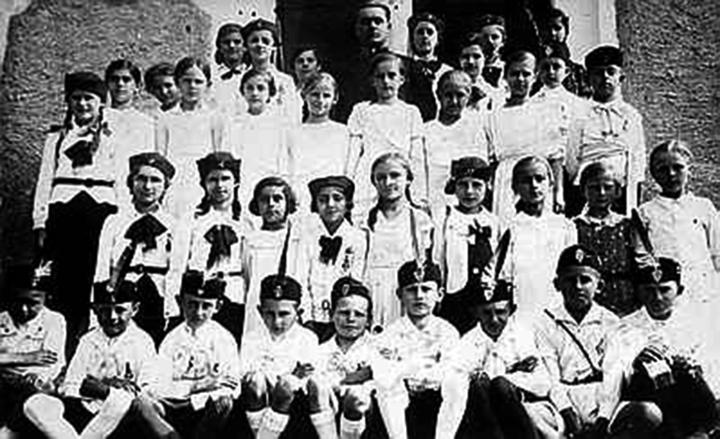
National Youth Groups: Hungary

Figure 1.--This photo looks to be taken at a Hungarian primary school. It was dated 1942. We think that the caps and neckerchiefs represent a Fascist youth group -- the Hungarista Örszem. We are not yet sure about it, but do not know how else to explain the uniforms. Many of the boys and girls seem to be wearing what look like campaign caps with an emblem. Notice also that some of the boys are wearing short trousers with white long stockings, suggesting that they were dressed up for the photograph. A few boys are wearing knee socks as an alternative to the stockings. Notice the floppy bows that are part of the girls' uniforms. The children look fairly young (9-10 years old).
|
|
The only important Hungarian boys youth group we know is the Scouts. There was a right-wing, highly nationalist youth organization, the Hungarista Örszem (Hungarian Sentinels). The group was, however, very small.
Hungary like other European countries had a right-wing Fascist organization--the Arrow Cross (Nyilaskeresztes Párt – Hungarista Mozgalom. It was led by Ferenc Szálasi. We are not sure to what extent the Hungarista Örszem was related to the pro-NAZI Arrow Cross, if any. The Hungarista Örszem was so small that virtually no information is available on the group. The 1942 photograph here, however, suggests that they were to some degree active in the schools. The country under German pressure joined the AXIS in World War II (October 1940) and Hitler rewarded the Hungarians with territorial awards, doubling the size of the country. Pál Teleki became Prime Minister again and Chief Scout of Hungary. Distraught that he could not keep Hungary out of World War II, he committed suicide (April 3, 1941). He was succeeded as Chief Scout by General Kisbarnaki Ferenc Farkas, Commander of Royal Ludvokia Akademia. German diplomats pushed for Hungary to ban Scouting which had an ethos inimical to the NAZI war effort. The NAZIs wanted to see a nationalist youth group, like the Hungarista Örszem. Similar groups along the lines of the Hitler Youth were promoted in many of the occupied countries and German allies. Scouting promoted an international brotherhood whereas the NAZIs wanted not only a radical reordering of European borders, but the murder of millions of unwanted ethnic groups as pat of Generalplan Ost. Farkas resisted this and as Scouting was so popular in Hungary, the Government supported Farkas. Hungarian officials having obtained desired territories, hoped to remain out of the actual fighting. This changed dramatically when Hitler ordered the invasion of the Soviet Union (June 1941). Hungary which was not consulted declared war, but did not participate in Barbarossa. After the Wehrmacht was stopped before Moscow and pushed back with heavy losses (December 1941), Hitler demanded Hungarian troops for the 1942 campaign. Hungarian Scouts during the War conducted many important activities. Three boys served as messengers and engaged in other helpful activities to support the War effort. The extreme right as the Germans exerted more pressure on Hungary gained influence. The Hungarian Scouting movement was affected and became increasingly militaristic and nationalistic during the War. The Germans allowed Hungary as an independent nation some latitude during the War. The Hungarian Scout movement was thus allowed to continue to function. They were able to maintain contact with the Boy Scouts International Bureau, the Polish Scout Headquarters in exile, and with Prince Gustav Adolf of Sweden, Chief Scout of Sweden and member of the World Scout Committee. This changed at the end of the War. Because of military disasters in the East, Hungary attempted to withdraw from the War. To stop this, Hitler seized control of Hungary (March 1944). The Hungarian Government ordered the Scouts to merge with the right-wing Hungarista Örszem. This was an attempt to give right-wing Örszem who had never been able to recruit many members, control of the substantial Scouting movement. As the Red Army drove west, Hungary became a battle ground of the War. The merger never really occurred to any degree in the chaos of war. After World War II when the country's Stalinist leaders banned Scouting, General Farkas remained Chief Scout of the Hungarian Scouts in Exile.
HBU

Navigate the Historic Boys' Uniform Chronology Pages:
[Return to the Main chronologies page]
[The 1900s]
[The 1910s]
[The 1920s]
[The 1930s]
[The 1940s]
[The 1950s]
[The 1960s]
[The 1970s]
[The 1980s]
[The 1990s]
[The 2000s]
Navigate the Historic Boys' Uniform Web Site:
[Return to the Main nationalist country page]
[Return to the Main Hungarian youth group page]
[Return to the Main Hungarian Workld War II page]
[Activities]
[Biographies]
[Chronologies]
[Countries]
[Essays]
[Garments]
[Organizations]
[Religion]
[Other]
[Introduction]
[Bibliographies]
[Contributions]
[FAQs]
[Questions]
[Unknown images]
[Boys' Uniform Home]
Navigate the Historic Boys' Uniform Web organizatiion pages:
[Boys' Brigade]
[Camp Fire]
[Hitler Youth]
[National]
[Pioneers]
[Royal Rangers]
[Scout]
Created: 10:47 PM 7/17/2013
Spell checked: 9:40 AM 7/18/2013
Last updated: 9:40 AM 7/18/2013



